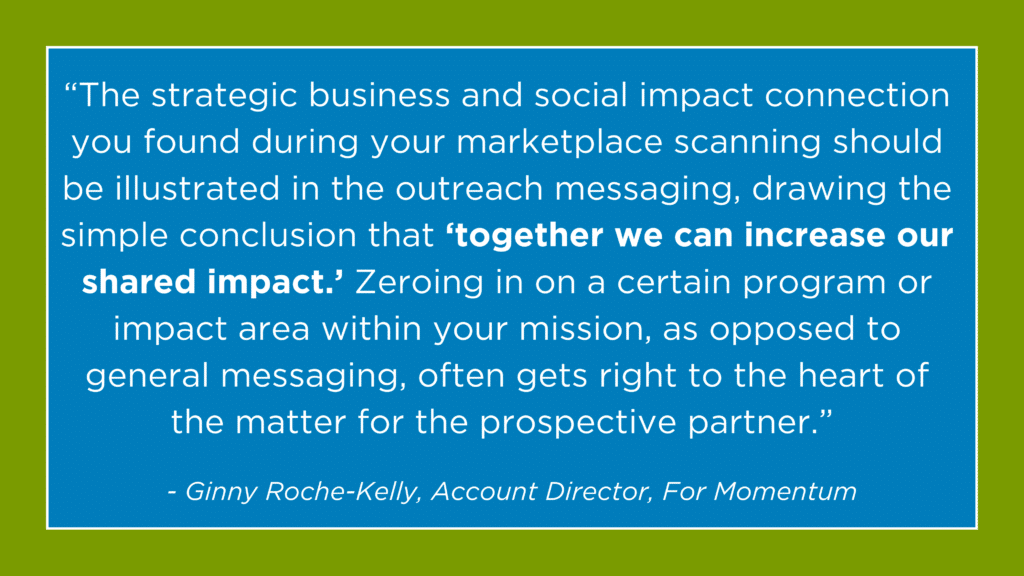By: Sarah D’Amico
The social impact landscape is filled with meaningful partnership stories where companies help nonprofits amplify their impact. At the same time, attracting and retaining new corporate partners is a time-consuming process that requires a thoughtful, strategic approach. First, nonprofit organizations need to invest in developing a compelling partnership narrative and partner value proposition. Only then can the important work of cultivating corporate partners begin.
Prospect outreach can be an exciting and rewarding part of your development work. Making partnership connections is our specialty, and we’re sharing lessons learned in our three-part series, Landing Corporate Partners. In this first installment, we’ll walk you through best practices for:
- Developing a solid pipeline of potential partners
- Creating compelling sales materials
- Launching your outreach efforts
Marketplace Scanning
The first step to securing new corporate partners is to identify companies that have giving priorities that align with your organization’s mission. We recommend conducting marketplace scanning, which is researching and analyzing potential partners, including their:
- Corporate social responsibility (CSR) initiatives
- Current partnerships
- Values
This will help you identify companies that are likely to be interested in partnering with your organization.
Here are a few ways you can conduct marketplace scanning:
- Look at geographic areas where your programming focuses. Find companies that have headquarters, offices or large employee bases in the same area. Many companies focus their giving around office and employee locations.
- Review the CSR and environment, social, governance (ESG) sections of potential partners’ annual reports to see areas of priority giving.
- Identify companies that have supported organizations with mission and impact areas similar to yours. You may not want to approach the exact same companies, but looking at competitors or companies in the same industry is valuable.
Sales Materials
Once you have a list of potential partners, it’s time to create or refine your suite of sales materials. These tools should highlight your organizational impact and make a compelling case for partnership.
Sales deck
An essential sales tool is a partnership pitch deck that communicates your organization’s mission and goals and shows how they align with the prospect’s mission or giving pillars. The deck should also provide a clear overview of the opportunities available and the benefits of partnering with your organization.
Outreach emails
Effective outreach emails are key to securing interest. These emails to key prospects should be tailored to their specific areas of alignment. Be brief and engaging in conveying the benefits of partnering with your organization. Invite the prospect to learn more.
Two-page overview
Corporate prospects love a high-level overview and often request it before taking a meeting. Prepare a two-pager outlining the same opportunities and benefits featured in your pitch deck but in a condensed, easy-to-reference way. This can be shared with prospects after initial meetings or with prospects who may not be ready to hop on a call without more information.
It’s important to ensure that your sales materials are visually appealing, brief and easy to understand. As much as possible, they should also be customized to the specific needs and interests of each prospect.
Outreach
Once you’re happy with your sales materials, it’s time for the fun part: beginning outreach to potential partners. You can use various channels, including email or LinkedIn messaging. When reaching out to prospects, it’s important to:
- Be clear and concise in your communication
- Highlight the benefits of partnering with your organization
- Explain how their partnership can make a difference in achieving your organization’s mission
- Tailor your outreach to the specific interests of each prospect
Follow up with prospects after the initial outreach to continue gauging their interest in partnering in hopes of scheduling a meeting to discuss the opportunity further. Don’t assume that because the prospective partner doesn’t respond immediately, they’re not interested. We recommend following up several times before giving up on a prospect as unresponsive.




Leave a Reply